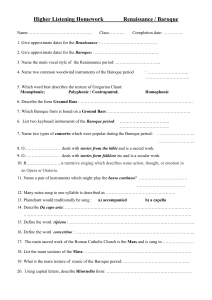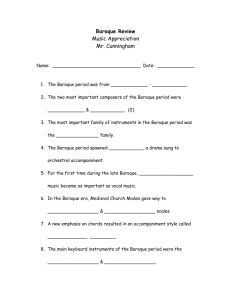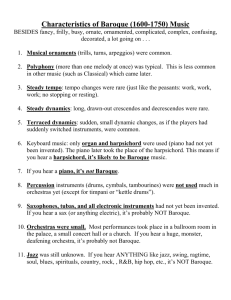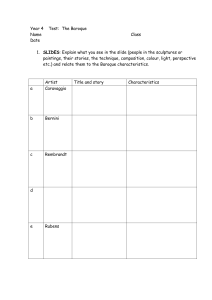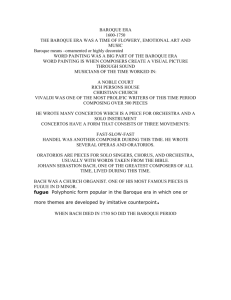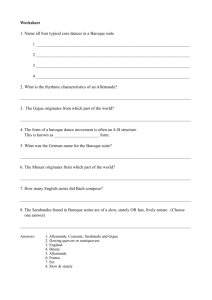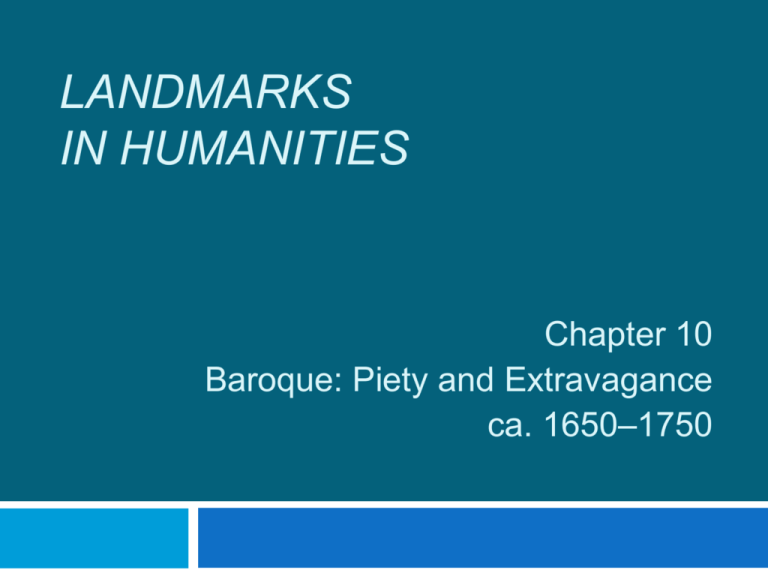
LANDMARKS
IN HUMANITIES
Chapter 10
Baroque: Piety and Extravagance
ca. 1650–1750
The Catholic Reformation
2
Loyola and the Jesuit Order
Ignatius
Loyola, fervent Spanish Catholic
Society of Jesus
“Soldiers
of Christ”; monastic order of the Catholic
Reformation
Militant return to fundamental Catholic dogma
Strict enforcement of traditional Church teachings
Amalgam
Spiritual Exercises
Council
of mysticism and militant religious zeal
of Trent
Reconfirmed seven sacraments; reasserted traditional
Catholic position on all theological matters
©2013, The McGraw-Hill Companies, Inc. All Rights Reserved.
The Catholic Reformation
3
Mannerist Painting
Surge
in artistic activity spurred by Catholic
reformers
Mannerism
Spatial
complexity, artificiality, and affectation
Psychological intensity
Parmigianino
Madonna
El
of the Long Neck
Greco
The
Agony in the Garden
Captured mystical fervor of new Catholicism
©2013, The McGraw-Hill Companies, Inc. All Rights Reserved.
The Catholic Reformation
4
Music and the Catholic Reformation
Council
of Trent tried to rid sacred music of
secular influence
Banned
complex polyphony; message of text primary
Palestrina, Pope Marcellus Mass
A cappella
“Music of mystic serenity”
©2013, The McGraw-Hill Companies, Inc. All Rights Reserved.
The Italian Baroque
5
The Italian Baroque
Baroque:
artistic style dominated by florid
ornamentation, spatial grandeur, theatrical
flamboyance
Enhanced
piety; extravagant settings
Italian Baroque Architecture
Saint
Peter’s basilica
Michelangelo
Bernini
Piazza of St. Peter’s; baldacchino
©2013, The McGraw-Hill Companies, Inc. All Rights Reserved.
The Italian Baroque
6
Italian Baroque Sculpture
Bernini
was leading sculptor
David
The
Ecstasy of Saint Teresa
Theatrical; illusionist
Italian Baroque Painting
Realistic
detail; illusionistic effects
Light/dark
contrast
Foreshortening
©2013, The McGraw-Hill Companies, Inc. All Rights Reserved.
The Italian Baroque
7
Caravaggio
The
Crucifixion of Saint Peter
Lifelike realization of natural world
Appeal to senses rather than intellect
Gentileschi
Judith
Slaying Holofernes
Female painter; favorite subject was biblical heroines
Pozzo
Church
of Sant’Ignazio, Rome
©2013, The McGraw-Hill Companies, Inc. All Rights Reserved.
The Northern Baroque
8
The Northern Baroque
Protestants
stripped churches of ornamentation;
Bible exercised influence on the arts
Patronage of middle class; interest in secular life
The Rise of the English Commonwealth
“Glorious
Revolution” (1688)
Constitutional
government established
Bill of Rights (1688)
Toleration Act (1689)
©2013, The McGraw-Hill Companies, Inc. All Rights Reserved.
The Northern Baroque
9
The King James Bible
“Authorized”
English-language edition of Old and
New Testaments
Lasting
influence on English language, literature
Donne
Developed
sermon as vehicle for philosophic
meditation
Meditations
“Conceits”
Metaphysical
Holy
poetry
Sonnets
©2013, The McGraw-Hill Companies, Inc. All Rights Reserved.
The Northern Baroque
10
Milton
Political
activist
Challenged
English society with expository prose
essays
Desired
to compose a modern epic
Paradise
Lost
The London of Christopher Wren
Leading
architect of large-scale building activity in
London after fire destroyed much of city in 1666
Saint Paul’s Cathedral
©2013, The McGraw-Hill Companies, Inc. All Rights Reserved.
The Northern Baroque
11
Seventeenth-Century Holland
Holland
commercially active; citizens profited
Patrons
Maria
van Oosterwyck
Vanitas
of the arts; Golden Age of painting
Still Life (1668)
Vermeer
Master
of light
View of Delft
The Milkmaid
©2013, The McGraw-Hill Companies, Inc. All Rights Reserved.
The Northern Baroque
12
Rembrandt
Produced
Leading
landmark works in every genre
portrait painter
Captain
Frans Banning Cocq Mustering his
Company
Group
portraiture
Self-portraits
Self-Portrait
mirror history of his career
as Saint Paul (1661)
Christ
Preaching
Etching/printmaking
©2013, The McGraw-Hill Companies, Inc. All Rights Reserved.
The Aristocratic Baroque
13
The Aristocratic Baroque
Emerged
Absolute
in Western European royal courts
monarchy
Louis XIV of France
Louis XIV and the Arts
Created
and subsidized government-sponsored
institutions in the arts (academies)
Neoclassicist
“The Sun King”
Used arts for propaganda value
©2013, The McGraw-Hill Companies, Inc. All Rights Reserved.
The Aristocratic Baroque
14
Louis
XIV moved capital from Paris to Versailles
Symbol
of absolute order
Baroque synthesis of Classical and Palladian
elements
Magnificent gardens; symbolic of royal grandeur
Hall of Mirrors
©2013, The McGraw-Hill Companies, Inc. All Rights Reserved.
The Aristocratic Baroque
15
Theater Arts
Louis
established first permanent orchestra
All members of court expected to perform basic
dances; minuet was favorite
Extravagant ballets in which Louis participated
Birth of professional dance; dance as
independent art form
Choreography
©2013, The McGraw-Hill Companies, Inc. All Rights Reserved.
The Aristocratic Baroque
16
Louis
also greatly influenced theatrical
performance
Molière
Comedies
focused on comic foibles of society
The Misanthrope
Dramatic
Rules
tragedies popular in Paris
fixed by Academy
Morally uplifting; high-minded; Greek or Roman literary
characters
Pierre
Corneille; Jean Racine
©2013, The McGraw-Hill Companies, Inc. All Rights Reserved.
The Aristocratic Baroque
17
Academic Art
Academy
required artists to use formalized rules
of the Grand Style
Poussin
Arcadian
Shepherds
The Aristocratic Baroque Portrait
Rigaud,
Portrait of Louis XIV
Van Dyck
Charles
I on Horseback
©2013, The McGraw-Hill Companies, Inc. All Rights Reserved.
The Aristocratic Baroque
18
Velázquez and Rubens
Velázquez
Las
was Spain’s most prestigious artist
Meninas (The Maids of Honor)
Rubens
Rape
of the Daughters of Leucippus
Power over privilege
©2013, The McGraw-Hill Companies, Inc. All Rights Reserved.
Baroque Music
19
Gabrieli
Composed
dramatic polychoral and instrumental
religious music
Use of acoustics
In ecclesiis
Concertato
“Father
of orchestration”
Dynamics
Advanced
system of major-minor tonality
©2013, The McGraw-Hill Companies, Inc. All Rights Reserved.
Baroque Music
20
The Birth of Opera
Emerged
out of Renaissance efforts to revive
music-drama of ancient Greek theater
Monteverdi
Orfeo
Music at the Court of Louis XIV
Jean-Baptiste
Lully
Neoclassical
themes
Included formal dance
©2013, The McGraw-Hill Companies, Inc. All Rights Reserved.
Baroque Music
21
Handel and the English Oratorio
Developed
the English oratorio
Homophonic
organization
Figured bass
Messiah
“Hallelujah
Chorus”
Bach and Religious Music
Cantatas
inspired by Luther; based on chorales
“A Mighty
Fortress is Our God”
Passion According to Saint Matthew
©2013, The McGraw-Hill Companies, Inc. All Rights Reserved.
Baroque Music
22
Instrumental Music
Rise
of music without extramusical text
Music
for its own sake
Refinements
Equal
in tuning
temperament
Standardization
Amati,
of musical instruments
Guarneri, Stradivari families of Cremona, Italy
Sonata
Suite
Concerto
©2013, The McGraw-Hill Companies, Inc. All Rights Reserved.
Baroque Music
23
Vivaldi
Leading
Italian composer of Baroque instrumental
music
Systemized concerto into three movements;
heightened contrasts between solo and ensemble
groups
The Four Seasons
Use
of program music
©2013, The McGraw-Hill Companies, Inc. All Rights Reserved.
Baroque Music
24
Bach and Instrumental Music
The
Brandenburg Concertos
Art of Fugue
©2013, The McGraw-Hill Companies, Inc. All Rights Reserved.
Beyond the West:
Aristocratic Landmarks
25
Japan
Tokugawa
dynasty
Shogun
enforced etiquette at court in Edo
Artistic production reached new heights
Irises at Yatuhashi
India
Shah
Jahan
Absolute
ruler; patron of the arts
Sumptuous palaces
Taj Mahal
Royal tomb for his favorite wife, Mumtaz Mahal
©2013, The McGraw-Hill Companies, Inc. All Rights Reserved.





